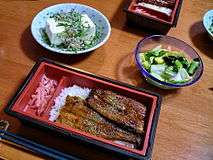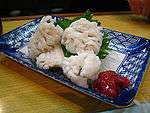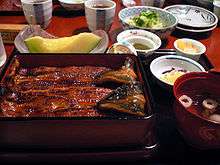Eel as food
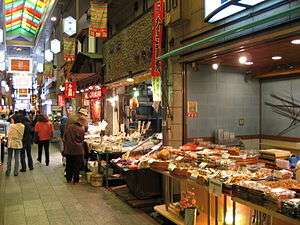
Eels are elongated fish, ranging in length from 5 centimetres (2.0 in) to 4 metres (13 ft).[1] Adults range in weight from 30 grams to over 25 kilograms. They possess no pelvic fins, and many species also lack pectoral fins. The dorsal and anal fins are fused with the caudal or tail fin, forming a single ribbon running along much of the length of the animal.[2] Most eels live in the shallow waters of the ocean and burrow into sand, mud, or amongst rocks. A majority of eel species are nocturnal and thus are rarely seen. Sometimes, they are seen living together in holes, or "eel pits". Some species of eels live in deeper water on the continental shelves and over the slopes deep as 4,000 metres (13,000 ft). Only members of the Anguillidae family regularly inhabit fresh water, but they too return to the sea to breed.[3]
Eel blood is poisonous to humans[4] and other mammals,[5][6][7] but both cooking and the digestive process destroy the toxic protein. The toxin derived from eel blood serum was used by Charles Richet in his Nobel winning research which discovered anaphylaxis (by injecting it into dogs and observing the effect).
The Jewish laws of Kashrut forbid the eating of eels.[8] Similarly, according to the King James version of the Old Testament, it is acceptable to eat fin fish, but fish like eels, which do not have fins, are an abomination and should not be eaten.[9]
Japan consumes more than 70 percent of the global eel catch.[10]
Types of food
Freshwater eels (unagi) and marine eels (anago, conger eel) are commonly used in Japanese cuisine; foods such as unadon and unajuu are popular but expensive. Eels are also very popular in Chinese cuisine and are prepared in many different ways. Hong Kong eel prices have often reached 1000 HKD per kilogram and once exceeded 5000 HKD per kilogram. Eel is also popular in Korean cuisine and is seen as a source of stamina for men. The European eel and other freshwater eels are eaten in Europe, the United States, and other places. Traditional east London foods are jellied eels and pie and mash, although their demand has significantly declined since World War II. In Italian cuisine eels from the Valli di Comacchio, a swampy zone along the Adriatic coast, are specially prized along with freshwater eels of Bolsena Lake.
| Locality | Type | Image | Description |
|---|---|---|---|
| England | Jellied eels | |
Jellied eels originated in 18th century England, mainly in the East End of London. The dish consists of chopped eels boiled in a spiced stock that is allowed to cool and set, forming a jelly. It is eaten cold. |
| Japan | Unagi | 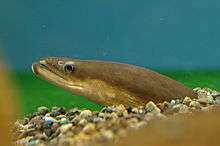 |
Unagi is the Japanese word for freshwater eels, especially the Japanese eel. Saltwater eels are known as anago. Unagi are a common ingredient in Japanese cooking. |
| Kabayaki | |
Kabayaki is a typical preparation of the unagi eel in Japan.,[11] sometimes extended to preparation of other fish,[12][13] where the fish is split down the back[12] (or belly), gutted and boned, butterflied, cut into square fillets, skewered, dipped in a sweet soy sauce-base sauce before broiled on a grill. | |
| Unadon | 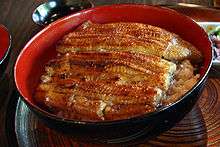 |
Unadon, lit. "eel bowl", consists of a donburi type large bowl filled with steamed white rice, and topped with fillets of eel grilled in the kabayaki style, similar to teriyaki. | |
| Widespread | Elvers |  |
Elvers are young eels. Traditionally, fishermen consumed elvers as a cheap dish, but environmental changes have reduced eel populations. Similar to whitebait, they are now considered a delicacy and are priced at up to 1000 euro per kilogram.[14] The Basque dish angulas consists of sautéd elver in olive oil, garlic and a chili pepper. In Spain, these angulas are now rare and very expensive (a small serving of angulas can cost to the equivalent of $US100 or more). There are also imitation angulas which can be purchased cheaply made of surimi.) |
| Smoked eel |  |
Smoked eel is considered a delicacy in many localities, such as northern Germany, the Netherlands, the Czech republic, Poland, Denmark and Sweden. |
Sustainability
In 2010, Greenpeace International added the American eel, European eel, and Japanese eel to its seafood red list. "The Greenpeace International seafood red list is a list of fish that are commonly sold in supermarkets around the world, and which have a very high risk of being sourced from unsustainable fisheries."[15]
History
The eel was a cheap, nutritious and readily available food source for the people of London; European eels were once so common in the Thames that nets were set as far upriver as London itself, and eels became a staple for London's poor. The first "Eel Pie & Mash Houses" opened in London in the 18th century, and the oldest surviving shop - M Manze - has been open since 1902.[16]
Gallery
| More images |
|---|
|
See also
| Wikimedia Commons has media related to Eel dishes. |
References
- ↑ McCosker, John F. (1998). Paxton, J.R.; Eschmeyer, W.N., eds. Encyclopedia of Fishes. San Diego: Academic Press. pp. 86–90. ISBN 0-12-547665-5.
- ↑ Froese, Rainer, and Daniel Pauly, eds. (2009). "Anguilliformes" in FishBase. January 2009 version.
- ↑ Prosek, James (2010). Eels. New York: HarperCollins. ISBN 978-0-06-056611-1.
- ↑ "Poison in the Blood of the Eel", New York Times, 9 April 1899, viewed at , accessed 22 January 2010
- ↑ "The plight of the eel", BBC online, as seen at , accessed 22 January 2010, mentions that "Only 0.1ml/kg is enough to kill small mammals, such as a rabbit..."
- ↑ "Blood serum of the eel." M. Sato. Nippon Biseibutsugakukai Zasshi (1917), 5 (No. 35), From: Abstracts Bact. 1, 474 (1917)
- ↑ "Hemolytic and toxic properties of certain serums." Wm. J. Keffer, Albert E. Welsh. Mendel Bulletin (1936), 8 76-80.
- ↑ Yoreh De'ah - Shulchan-Aruch Chapter 1, torah.org. Retrieved 17 June 2012.
- ↑ "All that are in the waters: all that... hath not fins and scales ye may not eat" (Deuteronomy 14:9-10) and are "an abomination" (Leviticus 11:9-12).
- ↑ "Indonesia eel hot item for smugglers". The Japan Times. Retrieved July 30, 2013.
- ↑ 本山, 荻舟 (Tekishū Motoyama) (1969) [1968]. かばやき (kabayaki). 世界百科事典(Sekai hyakka jiten). 7. Heibonsha., describes it as being used principally or almost always for unagi (「もっぱら鰻」)
- 1 2 Shinmura 1976 the Japanese dictionary says kabayaki applies to such fish as ungai, hamo, and dojō
- ↑ Hepburn 1888 J-E dict. defines "kabayaki: roasted flesh or fish".
- ↑
- ↑ Greenpeace International Seafood Red list
- ↑ "FACT SHEET - East End Food & Drink" (Doc). VisitEastLondon.co.uk. VisitEastLondon.co.uk. Retrieved 2008-12-11.
.jpg)


